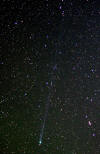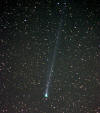

Comet C/2006 A1 Pojmanski
Closest to Sun: 2006 Feb 22nd at 0.55AU
Closest to Earth: 2006 March 4th at 0.77AU
Peak brightness: 5th magnitude in late Feb 2006.
Comet C/2006 A1 Pojmanski on 2006 February
28.78UT.
Left: 2x2 minute exposure. Canon 300D digital camera + 90mm telephoto
lens. Field of View approximately 8 degrees high.
Note the ion tail is at least 8 degrees in length.
Alpha Capricornus is to the right.
Right: 2x2 minute exposure. Canon 300D
digital camera + 200mm telephoto lens. Field of View 4 degrees high.
The comet shone at magnitude 5.4 with a coma diameter of 5' and tail >5
degrees in 25x100mm binoculars.
Grzegorz Pojmanski, Warsaw University Astronomical Observatory, reported
his discovery of a diffuse comet with a coma diameter of 1' on 3-min CCD
frames taken on 2006 Jan. 1 and 4 with a 180-mm-focal-length f/2.8 telephoto
lens in the course of the All Sky Automated Survey at Las Campanas.
In January 2006, the comet could only be seen from the Southern Hemisphere and
was well placed for viewing in the southern evening sky. It brightened from
magnitude 10 to 7 as it traversed the constellations of Pavo and Indus.
By the start of February 2006, the comet swung over into the morning sky and
rapidly brightened during the month from magnitude 7 to 5 as it headed
northwards. It traversed the constellations of Telescopium, Sagittarius and
Capricornus. By the start of March 2006, the comet was rapidly lost to the Southern
hemisphere as it continues its northward trek.